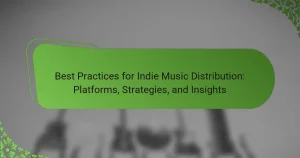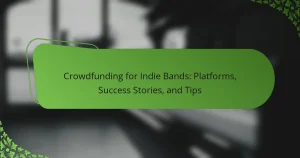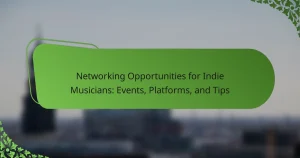Indie musicians often struggle with visibility and engagement on social media. Key platforms like Instagram, Facebook, and TikTok offer unique tools for promotion. Effective strategies include creating authentic content, collaborating with influencers, and analyzing engagement metrics. Understanding emerging trends and avoiding common pitfalls can enhance an artist’s reach and connection with fans.
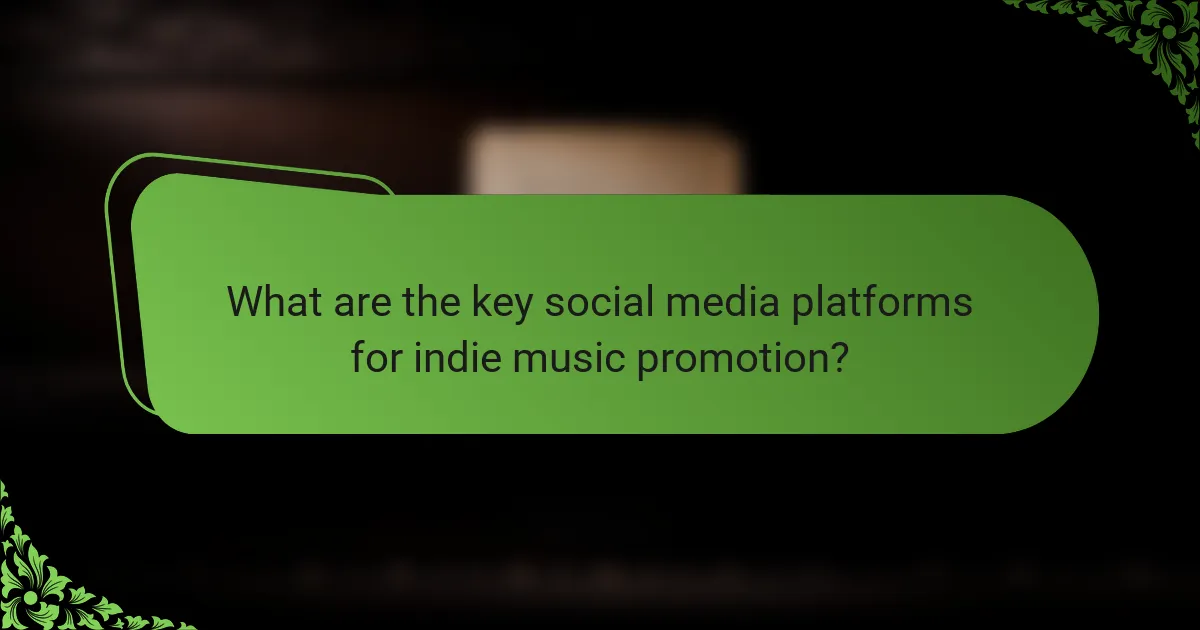
What are the key social media platforms for indie music promotion?
The key social media platforms for indie music promotion include Instagram, Facebook, Twitter, TikTok, YouTube, and SoundCloud. Each platform offers unique tools and audience engagement strategies.
Instagram excels in visual storytelling, making it ideal for sharing artistic content. Facebook provides community-building features, allowing artists to connect with fans through groups and events. Twitter facilitates real-time interactions and updates, while TikTok’s viral trends can amplify music discovery. YouTube serves as a primary platform for music videos and tutorials, and SoundCloud specializes in music sharing and networking among artists.
How does audience engagement differ across platforms?
Audience engagement varies significantly across social media platforms. Each platform has its unique audience preferences, interaction styles, and content formats.
For instance, Instagram thrives on visual storytelling, with high engagement for images and short videos. Facebook users often prefer longer posts and community interactions, making it suitable for discussions and event promotions. Twitter focuses on real-time updates and concise messaging, appealing to quick interactions. TikTok emphasizes creative, short-form video content, attracting a younger demographic that values entertainment.
Understanding these differences allows indie musicians to tailor their promotion strategies effectively, leveraging the strengths of each platform to enhance audience connection and engagement.
Which platforms are most effective for specific music genres?
Instagram and TikTok are the most effective platforms for promoting indie music across various genres. Instagram’s visual storytelling engages audiences, while TikTok’s viral trends amplify music reach.
| Platform | Best Genre | Unique Attribute |
|———-|————|——————|
| Instagram | Pop | High engagement through visuals |
| TikTok | Hip-Hop | Viral challenges enhance exposure |
| Facebook | Rock | Community building via groups |
| YouTube | Electronic | Long-form content for deep engagement |
| Twitter | Indie | Real-time interaction with fans |
| SoundCloud | Alternative | Direct artist-to-fan connection |
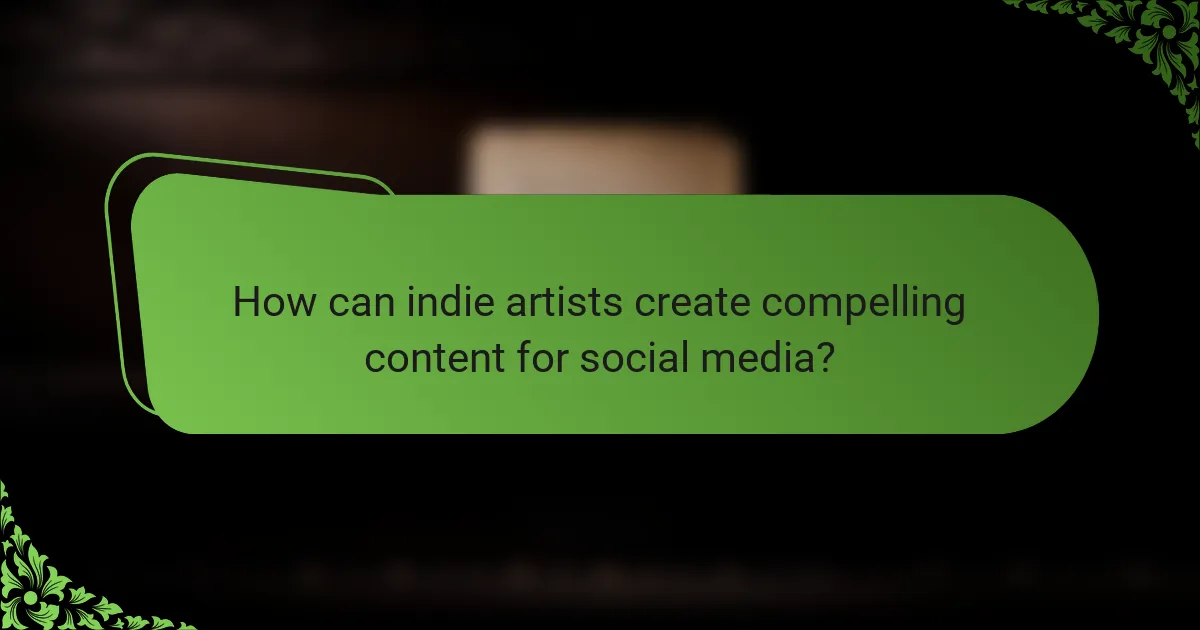
How can indie artists create compelling content for social media?
Indie artists can create compelling content for social media by focusing on authenticity, storytelling, and audience engagement. Utilize high-quality visuals and consistent branding to enhance recognition. Share behind-the-scenes content to foster a personal connection with fans.
Engage followers through interactive posts, such as polls or Q&A sessions, to encourage participation. Collaborate with other artists or influencers to expand reach and diversify content. Use analytics tools to track performance and adjust strategies accordingly.
Consistency in posting schedule is crucial; aim for regular updates to keep the audience engaged. Leverage platforms like Instagram, TikTok, and YouTube, which favour creative content formats.
Experiment with different content types, including live performances, tutorials, and music previews, to maintain interest and showcase versatility.
What types of visual content resonate with audiences?
Visual content types that resonate with audiences include videos, images, infographics, memes, and live streams. Each format engages users differently, enhancing the indie music promotion strategy. Videos capture attention quickly, while images evoke emotions. Infographics simplify complex information, and memes leverage humour to connect. Live streams foster real-time interaction, building community.
How important is storytelling in music promotion?
Storytelling is crucial in music promotion as it builds emotional connections with audiences. Engaging narratives can enhance a musician’s brand and increase listener loyalty. Effective storytelling on social media can showcase personal experiences, inspirations, and the creative process behind songs, making the music more relatable. Unique stories can differentiate indie artists in a crowded market, leading to increased visibility and engagement.
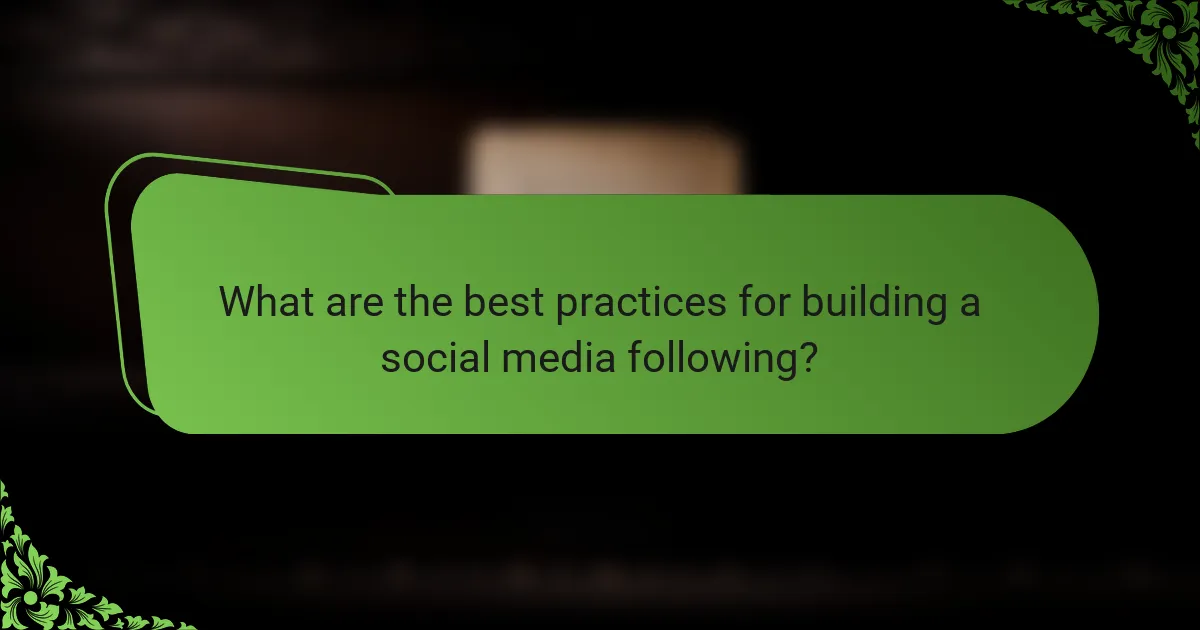
What are the best practices for building a social media following?
To build a strong social media following, focus on consistency, engagement, and authentic content. Regularly post high-quality content that resonates with your audience. Interact with followers by responding to comments and messages, fostering a community around your music. Utilize analytics tools to track engagement and adjust your strategies accordingly. Collaborate with other artists to expand your reach and leverage diverse audiences.
How can artists leverage collaborations for growth?
Artists can leverage collaborations for growth by expanding their audience, sharing resources, and enhancing creativity. Collaborations allow artists to tap into each other’s fan bases, increasing visibility and engagement. Joint projects can also reduce costs associated with production and marketing, making it easier to reach wider audiences. Furthermore, collaborating with diverse artists can inspire new ideas and innovative approaches, enriching the artistic process. By strategically choosing partners that align with their brand, artists can create meaningful connections that foster long-term growth.
What role does consistency play in audience retention?
Consistency is crucial for audience retention in social media strategies for indie music promotion. It builds trust and familiarity, encouraging followers to engage regularly. Regular posting schedules and cohesive branding reinforce the artist’s identity, making it easier for fans to connect. As a result, consistent messaging can enhance audience loyalty and drive long-term engagement.
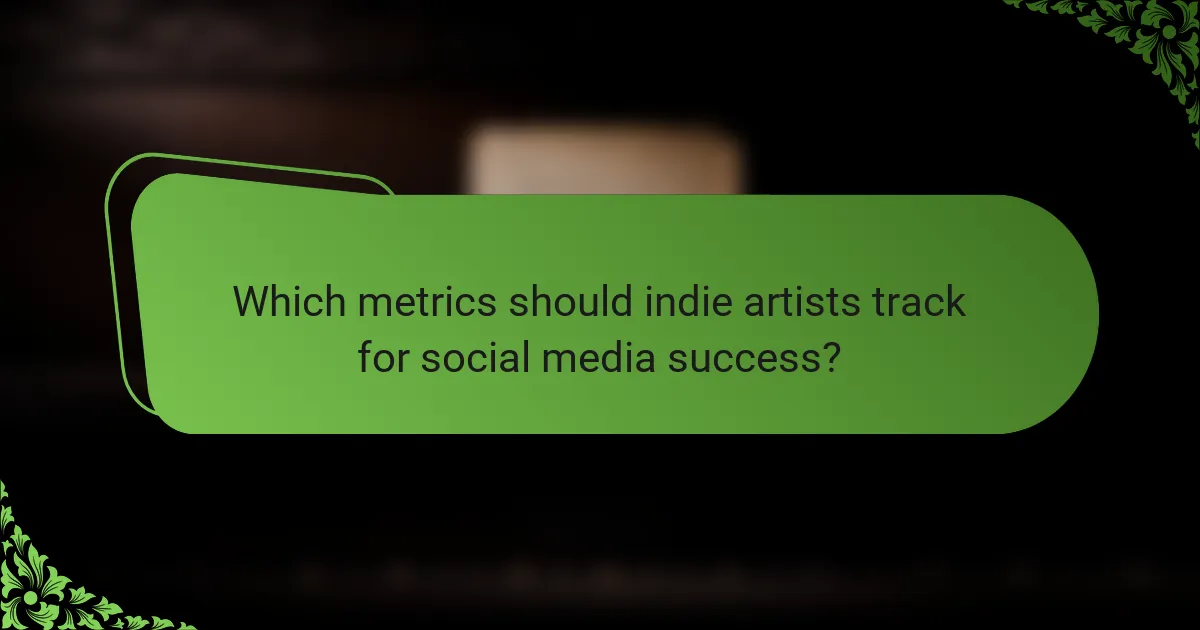
Which metrics should indie artists track for social media success?
Indie artists should track engagement rate, follower growth, reach, impressions, share rate, and conversion rate for social media success. These metrics provide insights into audience interaction and content effectiveness.
Engagement rate measures likes, comments, and shares relative to follower count. Follower growth indicates the increase in audience size over time. Reach shows how many unique users see the content, while impressions track total views. Share rate reflects how often content is shared, and conversion rate measures actions taken, such as streaming or purchasing music.
By focusing on these metrics, indie artists can refine their strategies and enhance their promotional efforts.
How can engagement rates inform content strategy?
Engagement rates are crucial for shaping content strategy in indie music promotion. High engagement indicates audience interest, guiding content creation and distribution. By analyzing likes, shares, and comments, artists can tailor their messaging to resonate with fans. This data informs the best times to post and the types of content that drive interaction, enhancing overall visibility and reach. Additionally, understanding engagement trends helps indie musicians identify their most loyal followers, allowing for targeted marketing efforts.
What does audience demographic data reveal about targeting?
Audience demographic data reveals insights about preferences, behaviours, and engagement, essential for effective targeting in indie music promotion. Understanding age, location, and interests helps tailor content and campaigns. For example, targeting younger audiences may involve platforms like TikTok, while older demographics might prefer Facebook. Analyzing this data enhances connection with specific groups, maximizing promotional impact.
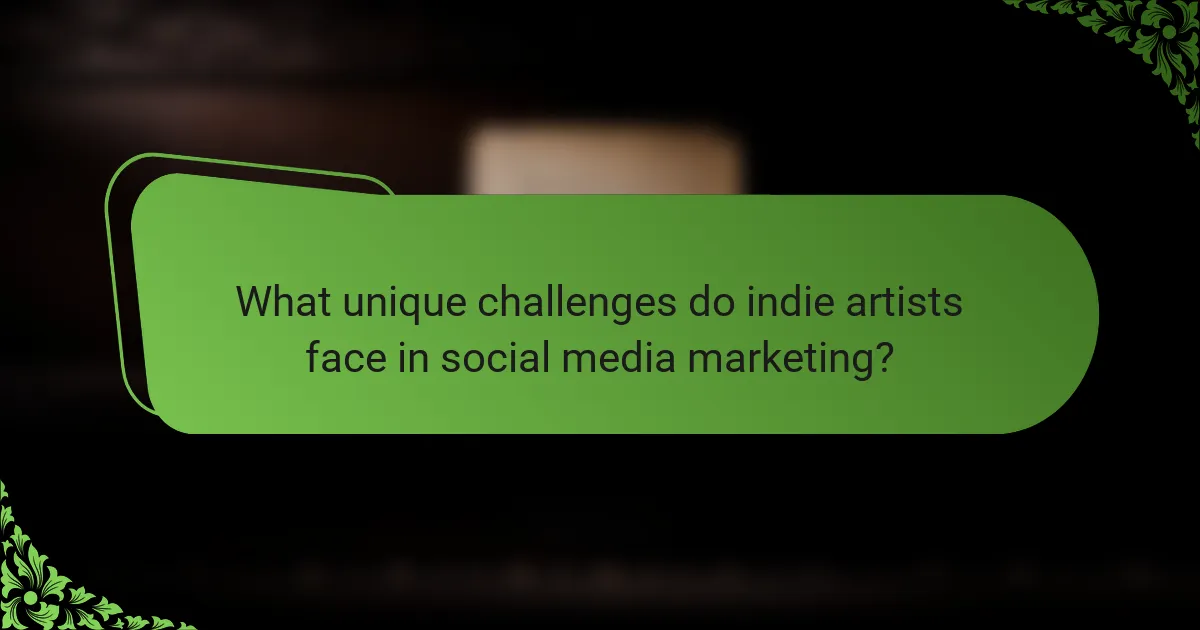
What unique challenges do indie artists face in social media marketing?
Indie artists face unique challenges in social media marketing, including limited budgets, lack of visibility, and competition from established acts. They often struggle to create engaging content consistently and may lack access to marketing expertise. Additionally, algorithm changes can impact their reach, making it difficult to connect with audiences. Building a loyal fanbase requires time and strategic planning, which can be overwhelming without adequate resources.
How can artists overcome budget constraints in promotion?
Artists can overcome budget constraints in promotion by leveraging cost-effective social media strategies. Utilizing platforms like Instagram and TikTok allows artists to reach audiences without significant financial investment. Engaging content, such as behind-the-scenes videos or live performances, fosters connection and builds a loyal fanbase.
Collaboration with other artists or influencers can amplify reach and share costs. Regularly interacting with followers through comments and messages enhances visibility and engagement. Additionally, utilizing analytics tools to track performance helps optimize promotional efforts effectively.
By prioritising creativity and resourcefulness, artists can maximize their promotional impact while minimising expenses.
What strategies exist for combating algorithm changes?
To combat algorithm changes, indie musicians should diversify their content strategies, engage with their audience, and utilize analytics tools. Regularly updating content ensures relevance and visibility. Collaborating with influencers can also enhance reach and adaptability.
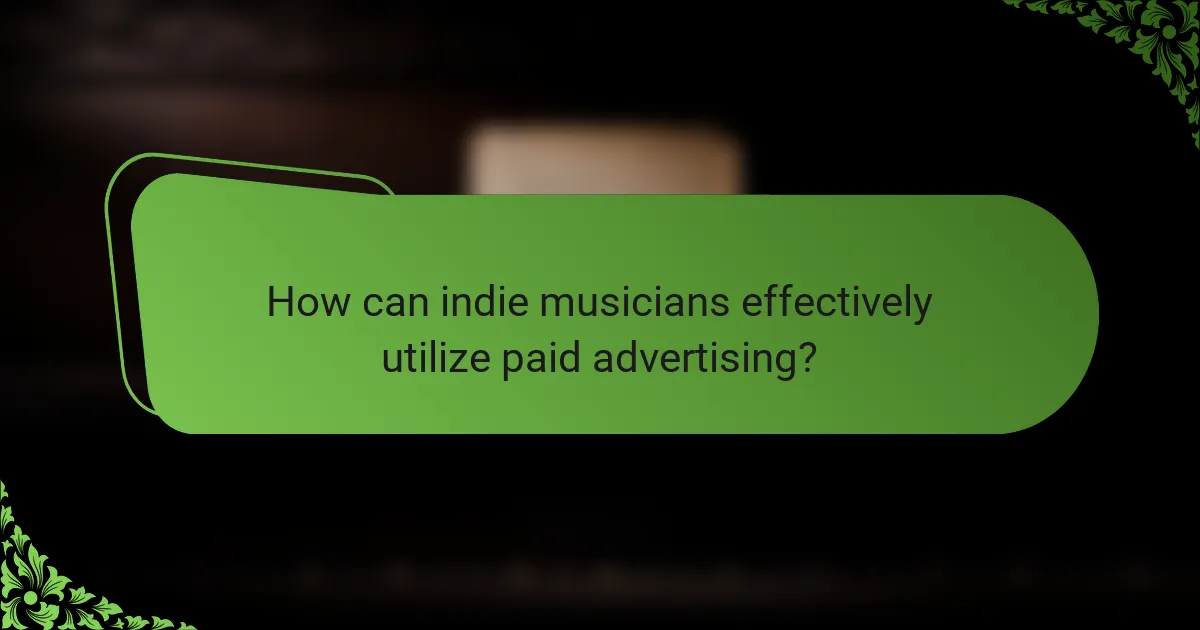
How can indie musicians effectively utilize paid advertising?
Indie musicians can effectively utilize paid advertising by targeting specific audiences on social media platforms. Focus on platforms like Facebook and Instagram, which offer robust targeting options based on demographics, interests, and behaviours.
Utilize eye-catching visuals and compelling calls to action to engage users. Experiment with different ad formats, such as video ads or carousel ads, to determine what resonates best with your audience.
Set clear goals for your campaigns, such as increasing streams or promoting a new release, and track performance metrics to optimize future spending. Allocate budgets wisely, starting small and scaling up based on successful ad performance.
Consider collaborating with influencers or other artists to amplify reach and credibility. This approach can enhance engagement and foster a community around your music.
What budget considerations should artists keep in mind?
Artists should budget for social media marketing costs, content creation, and platform-specific expenses. Allocate funds for advertising, graphic design, and video production to enhance promotional efforts. Consider the potential return on investment from targeted campaigns. Monitor analytics to adjust spending based on performance metrics.
Which ad types yield the best results for music promotion?
Video ads yield the best results for music promotion on social media. They engage users visually and audibly, enhancing emotional connection. Additionally, carousel ads allow showcasing multiple tracks or albums, maximizing exposure. Targeted ads using audience insights improve reach and conversion rates. Using analytics tools helps refine strategies for optimal performance.
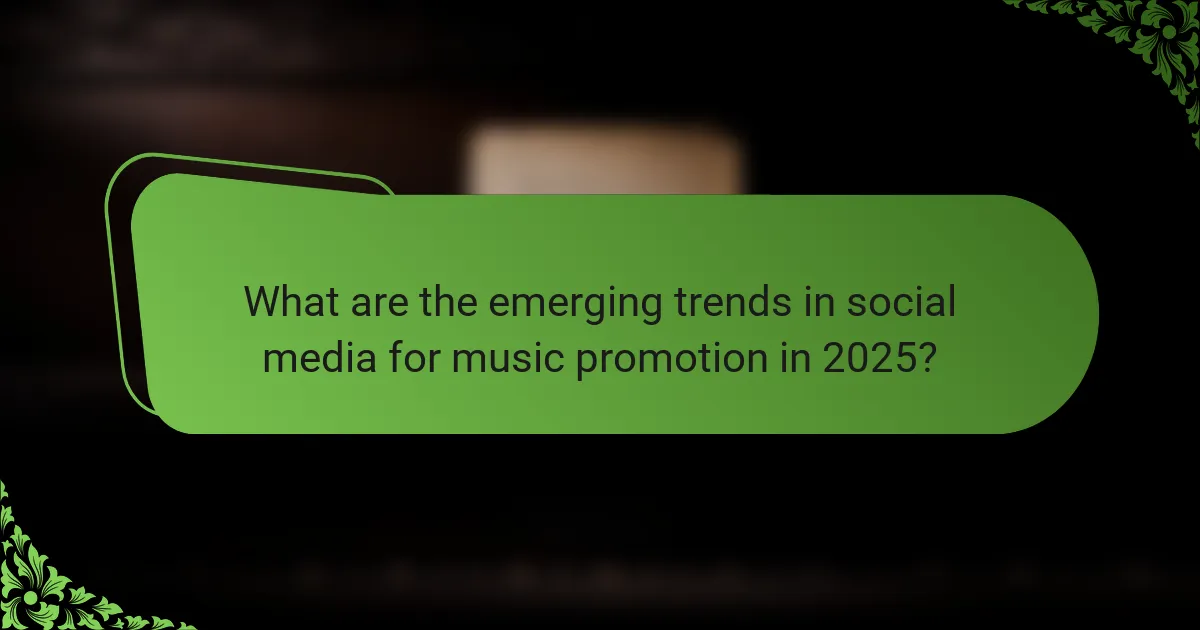
What are the emerging trends in social media for music promotion in 2025?
Emerging trends in social media for music promotion in 2025 include the rise of immersive experiences, AI-driven content personalization, and the growth of short-form video platforms. Artists will leverage virtual reality to engage fans and create unique listening experiences. AI tools will tailor promotional content to individual preferences, enhancing user engagement. Additionally, platforms like TikTok will continue to dominate, prioritising authentic and relatable content to connect with audiences.
How is user-generated content shaping marketing strategies?
User-generated content significantly influences marketing strategies by fostering authenticity and engagement. Brands leverage user-generated content to build trust and connect with audiences. This approach enhances brand loyalty and encourages community participation. For indie music promotion, incorporating user-generated content can amplify reach and create a sense of belonging among fans. Engaging fans through social media platforms allows artists to showcase their work while encouraging fans to share their experiences. This strategy not only increases visibility but also creates a dynamic relationship between artists and their audience.
What role do live-streaming events play in audience engagement?
Live-streaming events significantly enhance audience engagement by fostering real-time interaction. They allow indie musicians to connect directly with fans, creating a sense of community and immediacy. This format encourages participation through comments and reactions, making fans feel valued. Additionally, live-streaming can showcase exclusive content, driving interest and loyalty. As a result, it serves as a powerful tool for promoting indie music and expanding reach.
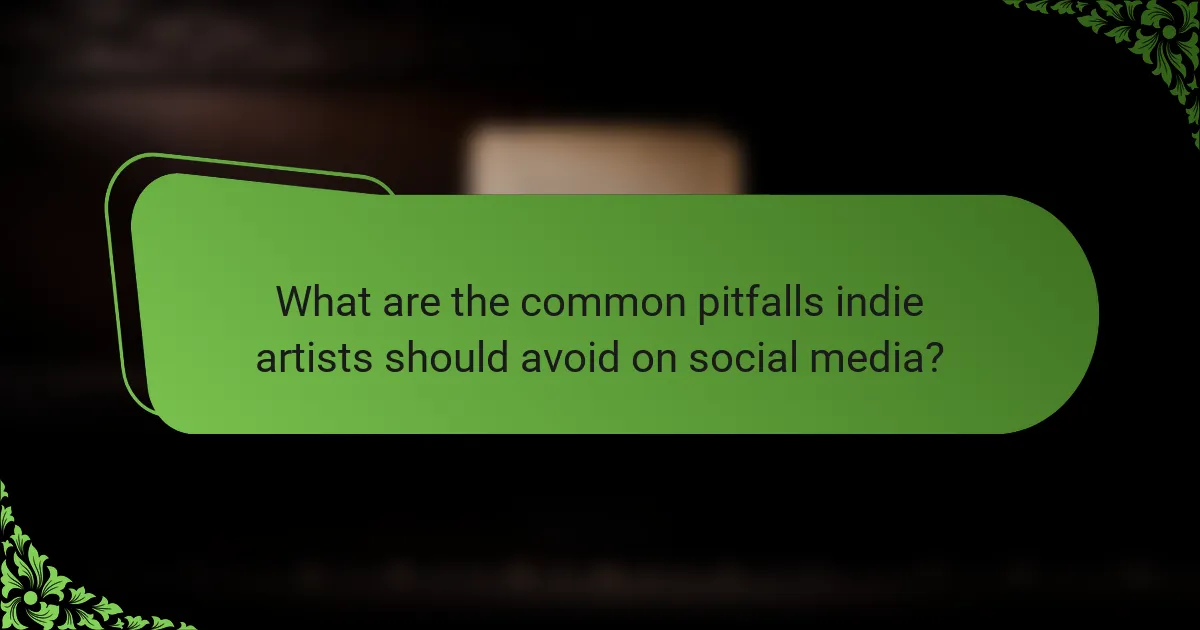
What are the common pitfalls indie artists should avoid on social media?
Indie artists should avoid overposting, neglecting engagement, inconsistent branding, and ignoring analytics. These pitfalls can hinder audience growth and limit promotional effectiveness.
Overposting can overwhelm followers, leading to unfollows. Neglecting engagement with fans can create a disconnect, reducing loyalty. Inconsistent branding confuses potential listeners about the artist’s identity. Ignoring analytics prevents artists from understanding what content resonates, limiting future success.
How can artists maintain authenticity while promoting their work?
Artists can maintain authenticity while promoting their work by staying true to their unique style and values. They should engage genuinely with their audience, sharing personal stories and insights related to their music. Utilizing social media strategically involves creating content that reflects their artistic vision while also reaching potential fans. Consistency in messaging and visual branding reinforces their identity. Collaborating with like-minded artists can enhance visibility without compromising authenticity. Finally, artists should prioritise quality over quantity in their promotional efforts, focusing on meaningful interactions rather than chasing trends.
What mistakes do artists make in audience interaction?
Artists often make mistakes in audience interaction by failing to engage authentically, neglecting to respond to feedback, and focusing too much on self-promotion. These missteps can alienate fans and hinder relationship-building. For instance, not acknowledging comments or messages can create a sense of distance. Additionally, over-promoting without offering value can lead to audience fatigue. Prioritising genuine connections and responding to audience needs fosters loyalty and enhances promotional efforts.
What are the best practices for optimizing social media strategies?
To optimize social media strategies for indie music promotion, focus on audience engagement, content quality, and platform selection. Prioritize authentic interactions with fans to build a loyal community. Utilize high-quality visuals and audio to enhance posts, ensuring they resonate with your target audience. Select platforms that align with your music genre and demographics to maximize reach. Regularly analyze performance metrics to refine strategies based on data-driven insights.
